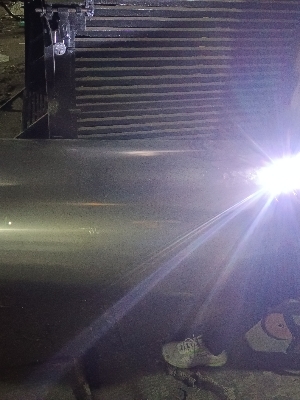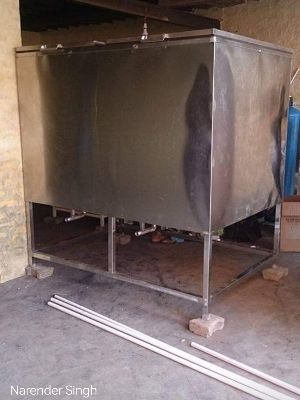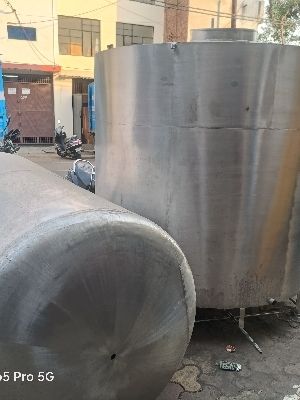Water Treatment Plant
Water Treatment Plant Specification
- Type
- Water Purifier
- Material
- Stainless Steel
- Storage Capacity
- 1000 litrs Liter (L)
- Purifying Function
- Filterstion
- Power
- 3hp Horsepower (HP)
- Valve Type
- Ball valve
- Installation Type
- Other
- Water Source
- Ground
- Voltage
- 440 Volt (v)
- Weight (kg)
- 120 Kilograms (kg)
- Warranty
- 12 month
Water Treatment Plant Trade Information
- Minimum Order Quantity
- 1 Kiloliter
- FOB Port
- Noida india
- Supply Ability
- 10 Per Month
- Delivery Time
- 10 Days
- Main Domestic Market
- All India
About Water Treatment Plant
A facility known as a water treatment plant cleans water from numerous sources so that it is suitable for human consumption and industrial usage. It entails procedures including pH balancing, pH coagulation, filtering, sedimentation, and screening. The facility cleans the water of impurities, silt, and dangerous bacteria to ensure that it complies with legal requirements. It meets industrial and agricultural demands, safeguards public health, and supplies clean drinking water. Infrastructure, monitoring systems, and cutting-edge treatment techniques are used in water treatment plants to provide dependable, clean water. By managing residuals and preserving water supplies, they support environmental sustainability. Overall, water treatment facilities are essential for ensuring that everyone has access to clean water, which is good for the environment, businesses, and communities.
The following are some characteristics and advantages of water treatment plants:
1. Water treatment facilities contain intake structures to gather water from the source. These structures also screen the water. Large material like twigs and leaves are removed by screening mechanisms like bar screens or fine mesh filters to keep them out of the treatment process.
2. Coagulation and flocculation: To produce tiny, clingy particles known as flocs, chemicals like alum or ferric chloride are added to water. These flocs draw in suspended particles, such as silt and germs, making it easier for them to settle and be removed.
3. Water is allowed to settle in big tanks for sedimentation and clarification, which encourages the gravitational separation of flocs and contaminants. Heavy particles are removed by sedimentation, and the removal of finer suspended solids is improved much further by clarifying.
4. Water is filtered through a variety of devices, usually made of layers of sand, gravel, and activated carbon. These filters eliminate any leftover dissolved pollutants, fine particles, organic materials, and suspended solids.
5. Water is treated with disinfectants like chlorine, chloramine, or ultraviolet (UV) radiation to kill or inactivate hazardous germs. This process helps to ensure that the water is safe to drink and gets rid of any possible waterborne illnesses.
6. pH Correction and Chemical Balancing: To bring the water's pH up to drinking water standards, lime or other chemicals are frequently added. Minerals may also be added to the water to enhance flavour and maintain chemical balance.
7. Advanced Treatment Methods: Additional treatment methods might be used, depending on the water source and the particular requirements. Advanced filtering methods, such as membrane filtration (such as reverse osmosis), or activated carbon adsorption for certain pollutants, can be among them.
9. Water treatment facilities regularly monitor the quality of the water they produce using online sensors and laboratory tests. This guarantees adherence to legal requirements and enables treatment procedures to be modified as necessary.
10. Reliable Infrastructure: To enable effective and dependable water treatment operations, water treatment plants are equipped with reliable infrastructure, such as tanks, pumps, pipelines, and control systems.
Water treatment facilities offer the following advantages:
- Providing regulated-standard compliant, clean, and safe drinking water.
- Removing or decreasing dangerous chemicals and bacteria that can lead to diseases that are spread by water.
- Improving water's flavour, smell, and appearance.
- Supplying towns and businesses with a steady and dependable water supply.
- Defending the general public's health by lowering the danger of water-borne infections.
- Delivering high-quality water to support industrial processes and agricultural irrigation.
- Enhancing environmental sustainability through the control and reduction of the effects of water treatment procedures.
- Helping to safeguard and conserve water resources.
- Supplying dependable, safe water for a variety of uses will improve the general wellbeing and standard of living for people and communities.


Price:
- 50
- 100
- 200
- 250
- 500
- 1000+
More Products in RO Systems Category
Send filter Vessel
Price 10000 INR / Piece
Minimum Order Quantity : 1 Liter
Warranty : 12 month
Installation Type : Other
Type : Water Purifier
Weight (kg) : 100 Kilograms (kg)
Water Chillers
Price 100000.00 INR / Piece
Minimum Order Quantity : 1 Piece
Warranty : 12month
Installation Type : Cabinet Type
Weight (kg) : 50kg Kilograms (kg)
Drinking Water RO Plant
Price 50000.00 INR / Unit
Minimum Order Quantity : 1 Kiloliter
Warranty : 12 month
Installation Type : Other
Type : Water Purifier
Weight (kg) : 100 Kilograms (kg)
Mineral Water Jar Washing System
Price 45000.00 INR / Unit
Minimum Order Quantity : 1 Unit
Warranty : 12 month
Installation Type : Cabinet Type
Type : Other
Weight (kg) : 50kg Kilograms (kg)








 Send Inquiry
Send Inquiry Send SMS
Send SMS